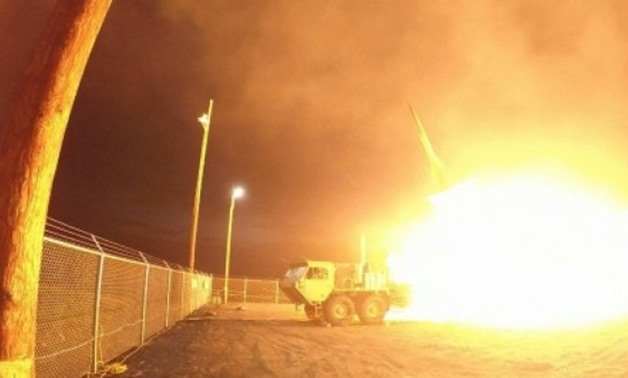
© MISSILE DEFFENSE AGENCY/AFP/File | The Terminal High Altitude Area Defense (THAAD) interceptor -- seen here being test-fired in Alaska earlier this year -- is intended to offer a new layer of defence against North Korean missiles
SEOUL - 7 September 2017: South Korea and the United States on Thursday completed the deployment of a US missile defence system to counter North Korean threats, sparking demonstrations by residents and a diplomatic protest from Beijing.
A convoy of US military trucks carrying four launchers for the Terminal High-Altitude Area Defense (THAAD) system made their way through an activists' blockade at a former golf course in the southern county of Seongju.
Some 8,000 riot police were mobilised to help the convoy get through the 400 protestors staging a sit-in. Many of the demonstrators had locked themselves into place with chains, while others had used tractors and pickup trucks as barriers.
Police shattered windows to break into the vehicles and tow them away, Yonhap news agency said. About 20 people were injured in subsequent scuffles, it added.
The system's powerful radar and two launchers had already been deployed, infuriating Beijing, which fears it could compromise its own missile capabilities. It has previously retaliated against Seoul with unofficial economic sanctions.
The installation of the rest of the battery was delayed, ostensibly on environmental grounds, by South Korea's new liberal President Moon Jae-In.
But Prime Minister Lee Nak-Yon said Thursday the THAAD deployment was a "difficult yet inevitable decision" Seoul had to make because of North Korea's growing nuclear and missile threats.
The North carried out its sixth and largest nuclear test at the weekend, which Pyongyang said was a hydrogen bomb that could be mounted on a missile. In July it launched two intercontinental ballistic missiles (ICBMs) that appeared to bring much of the US mainland within range.
Residents in the farming region of Seongju fear possible environmental and health risks from THAAD's radar, and say it could make their area a target in the event of conflict.
Beijing has imposed a tacit ban on Chinese tour groups visiting South Korea, and shut down more than 80 stores owned by the Lotte Group -- which handed the golf course THAAD site over to the government -- costing it around 500 billion won ($440 million).
Car firm Hyundai has also seen its first-half China sales plummet by 47 percent.
Beijing lodged a diplomatic protest with Seoul Thursday demanding the withdrawal of THAAD.
"Our stance on the THAAD issue has been consistent and clear," Chinese foreign ministry spokesman Geng Shuang said in Beijing.
"We demanded South Korea and the United States stop relevant deployment procedures immediately... in view of the security interest and concerns of regional neighbours, including China."

Comments
Leave a Comment